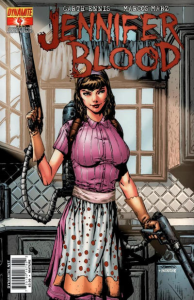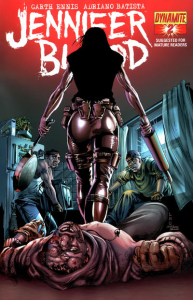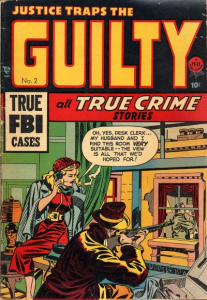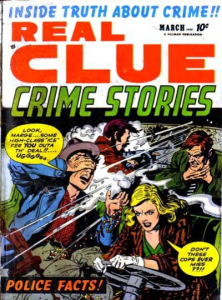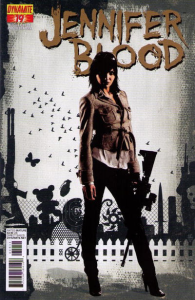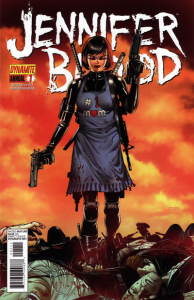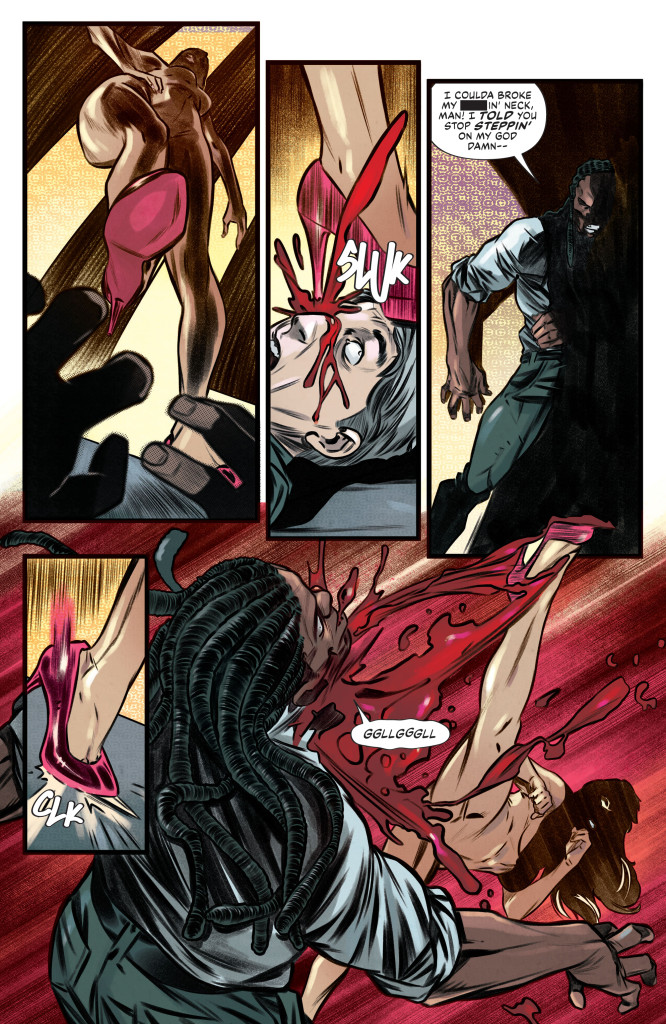Longtime readers of this blog know that I have an unhealthy fascination with fucked up vigilante comics that go into odd directions, so perhaps you won’t be surprised with my choice of devoting an entire post – probably one of Gotham Calling’s least Safe For Work posts – to the sinuous evolution of Dynamite’s lurid and bafflingly uneven Jennifer Blood.
Jennifer Blood started out, back in 2011, as a contender for Garth Ennis’ worst comic… It followed Jen Fellows, a soccer mom who secretly left the house every night, when her family was asleep, to go on a killing rampage against her mobster uncles, the Blute brothers (who had murdered her father). The initial joke was that Ennis wrote this housewife exactly as he wrote the Punisher, complete with a war journal and detailed descriptions of the firearms and ammo she used in the massacres. The obvious intertextual game was underscored by the no-nonsense covers of Tim Bradstreet, who had memorably illustrated the covers for Ennis’ stints on The Punisher and The Punisher MAX with a similar look.
I can clearly see the potential for laughs in the idea of a sociopathic, Frank Castle-like inner narration methodically focused on house chores, neighborly social interactions, or the children’s education… Sadly, however, while Garth Ennis can write competent vigilante/revenge fiction on auto-pilot, his approach to Jen Fellows’ world was so superficial that the setup didn’t really pay off. He was either too lazy or quickly grew uninterested in the series’ high concept, giving us only glimpses of the protagonist’s ‘normal’ life while spending most of the time on the gangster-slaughtering side of the story. Jen’s voice thus became a stand-in for Ennis’, briefly toying with the idea of dealing with the domestic milieu but ultimately only feeling comfortable when getting back to her roots.
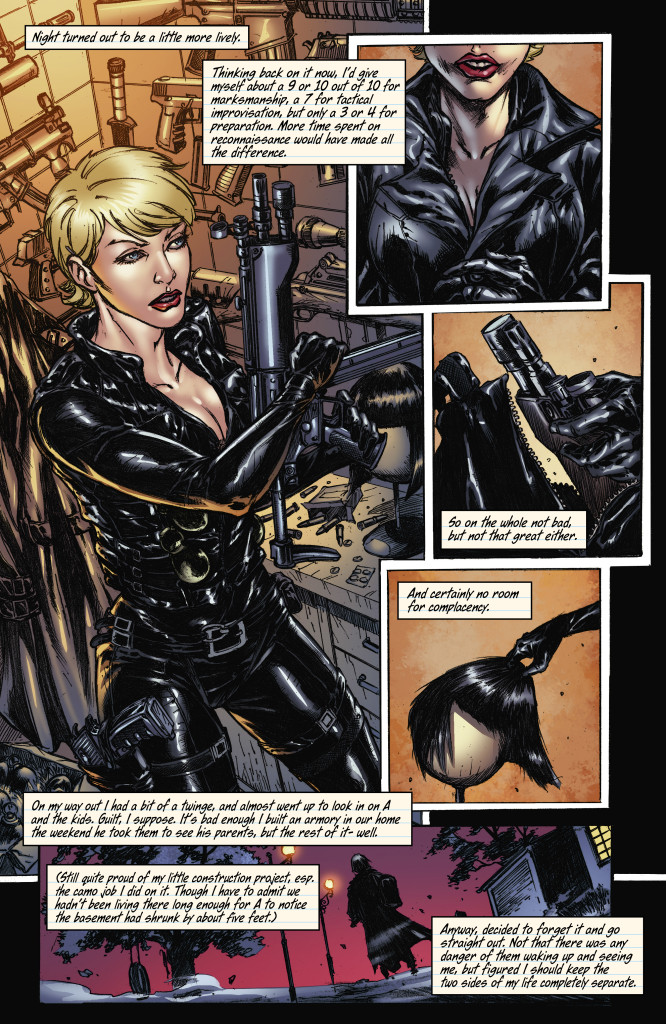 Jennifer Blood #1
Jennifer Blood #1
Hell, even the multiple cover images tended to play down the premise, preferring to go with softcore cheesecake – as Dynamite’s variants often do – in which Jennifer came across as just another gun-toting sexpot, usually sporting a tight, revealing outfit. Judging from the covers alone, the main target audience for the series appeared to be frat bros looking for carnage and objectified women, if not self-proclaimed incels with paramilitary fetishes…
Here are a few playful exceptions (by Johnny Desjardins, Jonathan Lau, and Tim Bradstreet) that at least tried to incorporate the contrast between the two sides of Jen’s life:
It was a dreadful affair. There were hints of Garth Ennis’ knack for bawdy slapstick (a subplot about bondage actually earned a few chuckles) and at times the comic almost threatened to turn into something provocatively uncomfortable – a la Paul Verhoeven’s Elle – but overall we were left with hacky, edgelord-ish humor that drew on stale ethnic and gender stereotypes.
You know you’re in trouble when the ‘cleverest’ thing about a crude Titanic-based gag is having the story’s title double as a Céline Dion soundtrack:
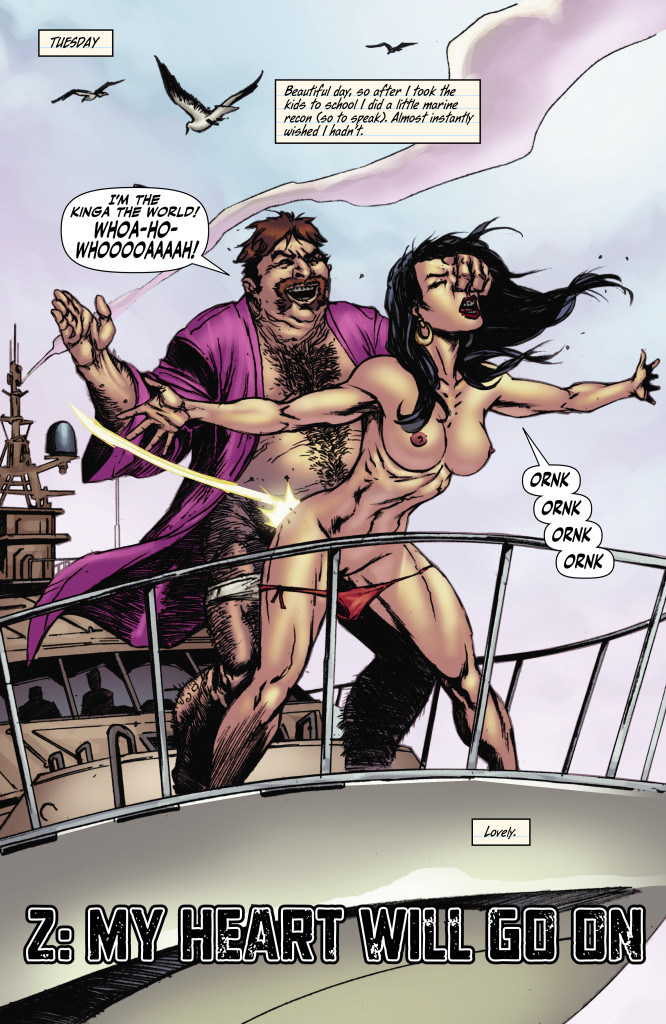 Jennifer Blood #2
Jennifer Blood #2
(A famous romantic moment is turned into an in-your-face sex scene, degradingly framed so as to invite both lustful contemplation of the woman’s full-frontal nudity and laughter at the way she’s being fucked… So witty.)
Jennifer Blood’s vengeance plot wasn’t particularly inventive either. Nor did it seem fully thought-out in its mechanics and ramifications, even at the most basic levels (for instance, Jennifer never once stopped to consider that she was possibly killing other parents and therefore recreating what had been done to her). And although I appreciate the framework of devoting each issue to one day in her mission (I’m a sucker for gimmicks!), it’s not enough to make up for the run-of-the-mill execution.
To make matters worse, Dynamite’s proofreaders missed plenty of distracting typos and Adriano Batista’s charmless artwork, followed by Marcos Marz’s stiff designs, lacked the necessary grace to carry the comedy and even some of the action. I’m not a big fan of Kewber Baal, but at least he brought a modicum of style and energy to the proceedings when he became the main artist, since issue #5 (he was helped by the fact that by then InLight Studios had taken over the coloring, thankfully replacing Romulo Fajardo Jr)…
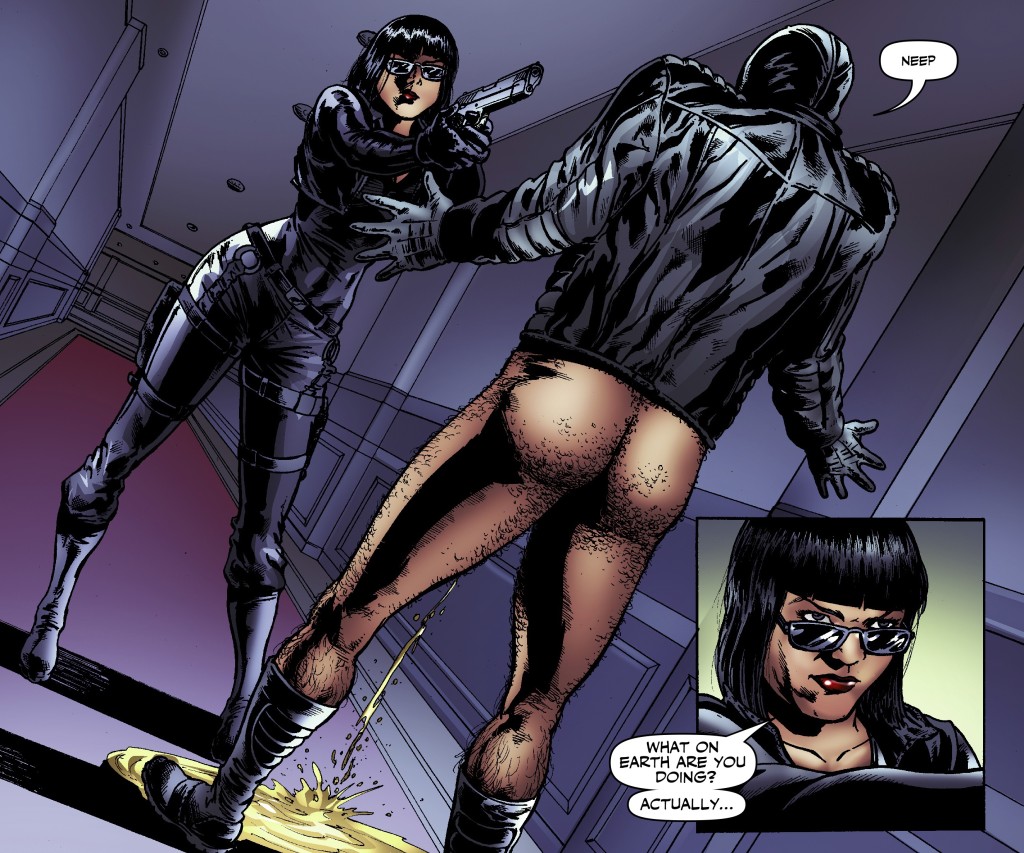 Jennifer Blood #6
Jennifer Blood #6
Sure, there is a primal element of exploitation in the trope of the badass, big-bosomed babe with big guns. The (thematic and visual) clash between a supposedly submissive feminine figure and the kind of violent aggression traditionally associated with the realm of macho men should at the very least produce a sense of Russ Meyer-ish, Jack Hill-ish grindhouse entertainment. However, in an era when such dichotomies have been repeatedly challenged and subverted, even this gesture is no longer shocking just by itself.
In fact, we’ve had plenty of comics about ruthless criminal dames going as far back as the 1940s and, more recently, Joëlle Jones and Jamie S. Rich had much more fun mining a similar situation, in Dark Horse’s Lady Killer.
After six disappointing issues, however, Jennifer Blood became an ongoing series written by Al Ewing, who squeezed every single one of Garth Ennis’ loose ends, often with interesting results. By dealing with all the unintended consequences of Jen’s actions in the first arc, including retaliation by the surviving relatives of some of her victims (which basically inverted her initial position), the comic became both more amusing (the greater focus on the suburban setting gave a perverse TV sitcom feel to the black comedy) and more tension-driven (the stakes were higher, as Jen now had to protect herself, her family, and her home while trying to safeguard her secret identity).
Ewing did a particularly impressive job of fleshing out Ennis’ paper-thin cast, deepening the characterization of several peripheral players, such as Jen’s kids, husband, and surrounding community, plus the cops investigating the various murders. He even did a spin-off mini-series, The Ninjettes, filling the background of a trio of assassins who had showed up in the original run for little more than a cheap gag (that mini actually ended up doing a lot of world-building, establishing a whole range of characters that returned in later issues of the main series).
Al Ewing’s run also properly delved into Jennifer’s own psychological layers and inner tensions, most notably in this neat scene at the church:
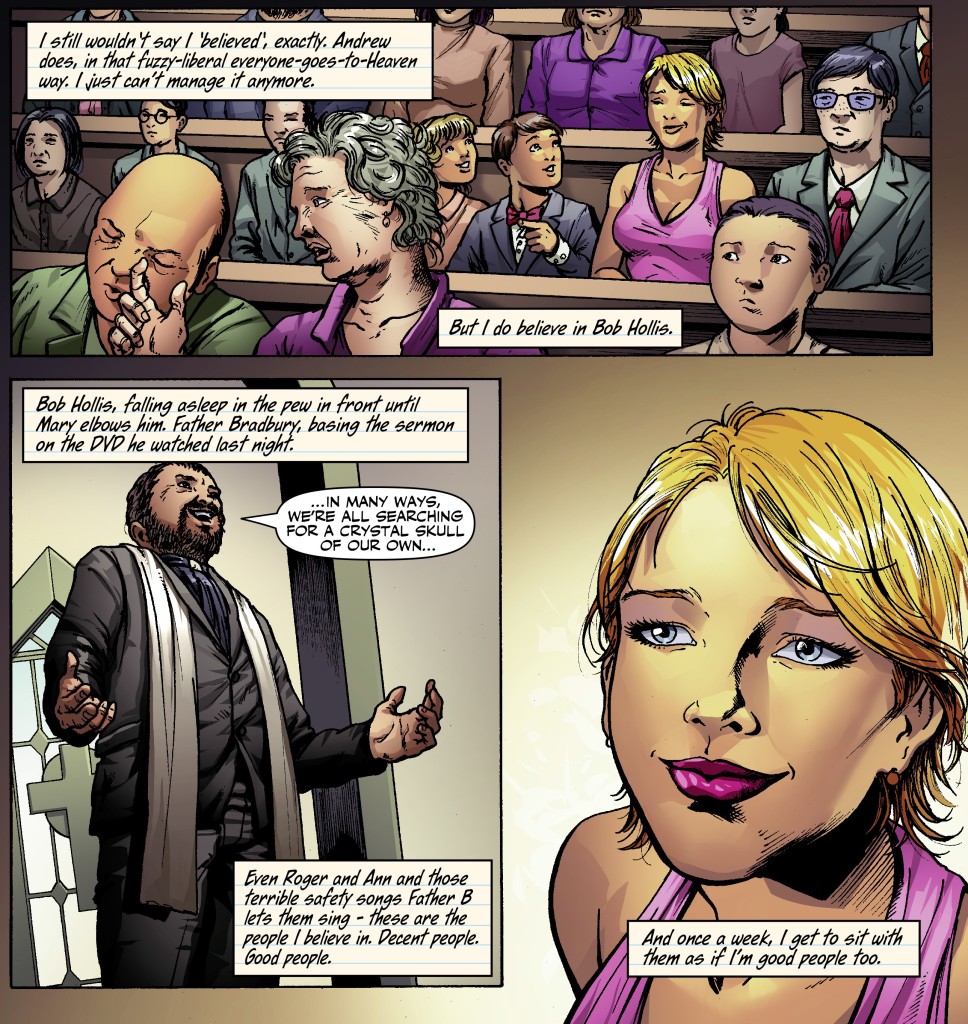 Jennifer Blood #7
Jennifer Blood #7
If Ewing’s first issues still read like an expertly crafted pastiche of a more inspired Ennis comic (baby ninjas!), the series soon began to morph into something thrillingly unpredictable. Following an old Punisher maxim, Jennifer gradually appeared as a villain in her own book, as we got to identify with the perspectives of those around her – and of those investigating her. Moreover, the comic finally fulfilled the earlier promise of imagining a housewife with the mindset of a serial killer systematically unleashing her murderous skills against neighbors and school teachers among white picket fences. Jen’s character arc – coupled with the overlap of mundane middle-class contexts and criminal violence hidden underneath ostensibly respectable business fronts – pushed the tone closer to that of one of the most popular shows coming out at the time, Breaking Bad (issue #19 even introduced a character that felt like a cross between Mike Ehrmantraut and Ed Galbraith).
Thus, while the covers continued to advertise the same type of trashy, sexist imagery, readers who picked up the comic now found inside it a smarter take on the material, not to mention a frenetically changing status quo. Eventually, Jen Fellows was revealed as a full-on maniac who didn’t truly care for her family as much as for an idealized lifestyle that she desperately sought in order to distant herself from her vicious origins. This was consistent with Jen’s actions and attitudes earlier on, even though it undermined the Punisher-esque crimefighting fantasy that Jennifer Blood appeared to be initially built on, replacing it with a more satirical farce that occasionally ventured into bone-chilling horror. In other words, the ensuing paradigm shift was worthy of Alan Moore, as it organically moved the series into an entirely new path by logically pursuing the implications of the opening stories.
That said, it wasn’t a complete overhaul. Kewber Baal’s art ensured a visual continuity (including the tendency to depict Jen through highly sexualized poses and leering angles). Likewise, Al Ewing’s scripts prolonged Ennis’ gimmick of repurposing song lyrics as chapter titles (though not ‘Jennifer Lost the War,’ which I guess would be too on the nose). They also made sure to live up to Jennifer Blood’s rowdy spirit by keeping a steady supply of gore, kinkiness, and profanity… The Ninjettes mini was particularly hilarious – artist Eman Casallos may not excel at drawing characters in a way that helps you easily tell them apart, but at least he committedly embraced the exploitative nature of the assignment:
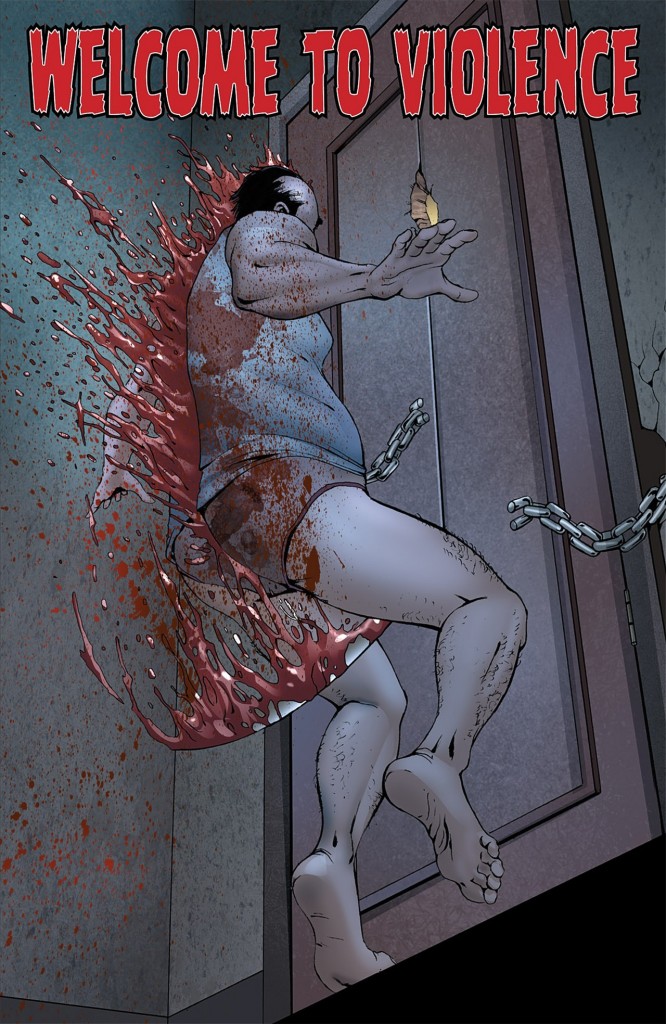 The Ninjettes #1
The Ninjettes #1
Ewing wrapped up his run with a trio of outstanding issues. ‘1965: My Father, the Monster’ (#24) and ‘1987: My Father, the Hero’ (Annual #1) were a couple of epilogues, set in the past, addressing Jen’s backstory and family origins. As for the incredible ‘This is the Story’ (#23), it had Jennifer, in prison, look back on everything that had happened and reframe it through different lenses. Her (mental) diary culminated in a reflection that worked both as a revealing insight about her self-perception and as a meta-commentary about the way such a commercially viable franchise was unlikely to preserve Ewing’s change of focus about the protagonist: ‘Eventually – one of these useless days – I’m going to find a way to make myself the heroine again. Eventually, there’s going to be that one perfect rationalization that justifies everything. Even now. Even after all of this. Because this is the story of Jennifer Blood.’ (Just to drive the point home, the issue finished with Jen apparently stabbed to death, even though Ewing and his editor presumably already knew the series was going to carry on…)
The main series was handed over to Mike Carroll, who wrote it until it was cancelled (at #36), presumably because he – like Ennis and Ewing – was a Judge Dredd veteran who knew how to straddle the line between having the audience root for mean leading characters and brazenly acknowledge their nastiness. Carroll didn’t exactly start off on the right foot: his first take on the property had been the lackluster mini Jennifer Blood: First Blood, which recreated the weeks leading up to the events of the original series. Talk about a slog… That one suffered from all the main problems of most prequels (fanfic flavor, needless explanations, no real suspense) while lacking the engaging shift in perspective of Better Call Saul or even Star Wars: Rogue One, not to mention the back-to-basics punch in the gut of a Batman: Year One or a Daredevil: The Man Without Fear (and artist Igor Vitorino was certainly neither Mazzuchelli nor Romita Jr.). And, sure enough, Carroll quickly turned Jen back into a cool anti-hero (hell, practically a superhero, given her credibility-straining body-healing abilities) by pitting her against all sorts of bastards and cannon fodder in a string of lean thrillers that generally lacked the irony, weirdness, and irreverence of the previous stories.
After a handful of issues, though, Mike Carroll at least seemed to recall that what made Jennifer Blood so special was that it had grown into a comic with a multifaceted take on vigilantism. Thus, before the rushed, convoluted ending, issues #31-33 did a nifty detour, looking at Jennifer’s wider impact even among people who didn’t know her personally but who were inspired or traumatized by her actions… or who sought to profit from them in different ways. These were effective standalone tales (one of which set in Carroll’s native Ireland), not least because they placed the emphasis on the series’ underlying theme of gender violence.
After a brief hiatus, Dynamite had another go at the character (one of the company’s few non-licensed properties) with 2014’s five-issue mini Jennifer Blood: Born Again, which picked up some months (a year?) after the end of the previous series, with Jen now hiding among a cult in Los Angeles. Instead of bringing in yet another European writer to imagine America as a land of mass murder, this time around the publisher went straight to the source and hired a homegrown creator who had pretty much established the formula for Punisher comics back in the day… Yet Steven Grant didn’t have much of a story to tell this time around, merely pitting Jennifer against a copycat (a dominatrix with a black ops background), plus a bunch of interchangeable, underdeveloped LA gangsters.
If Born Again was relatively bland and forgettable, Jennifer’s next appearance was way more eccentric. Perhaps as a response to the (understandable) accusations of misogyny regarding Dynamite’s output – especially in terms of ‘bad girl’ aesthetics – editors Hannah Elder and Molly Mahan invited the awesome Gail Simone to put together a feminist crossover starring the publisher’s female heroes and written by a host of talented women (albeit illustrated by artists that, in some cases, approached sexy bodies and postures with a fairly conventional male gaze, thus covering all the bases). The result was Swords of Sorrow, a confusing, overcrowded fantasy saga about a mysterious figure, known as The Traveller, who bestows magical blades to adventurers from different eras and dimensions in order to mount a defense against the reality-shattering Prince of All Universes… or something to that effect.
The core series had the ungrateful task of juggling dozens of characters from multiple schlocky franchises, thus wasting Gail Simone’s wit on a checkbox exercise meant to introduce the various cast members to readers (me included) who were bound to be unfamiliar with most of them. At the end of the day, not even Simone’s light touch could completely save this mess, although at least she got to write Red Sonja again (which she excels at) and she did make sure to constantly supply artist Sergio Dávila with the sort of imagery that channelled the various IPs’ pulpy roots:
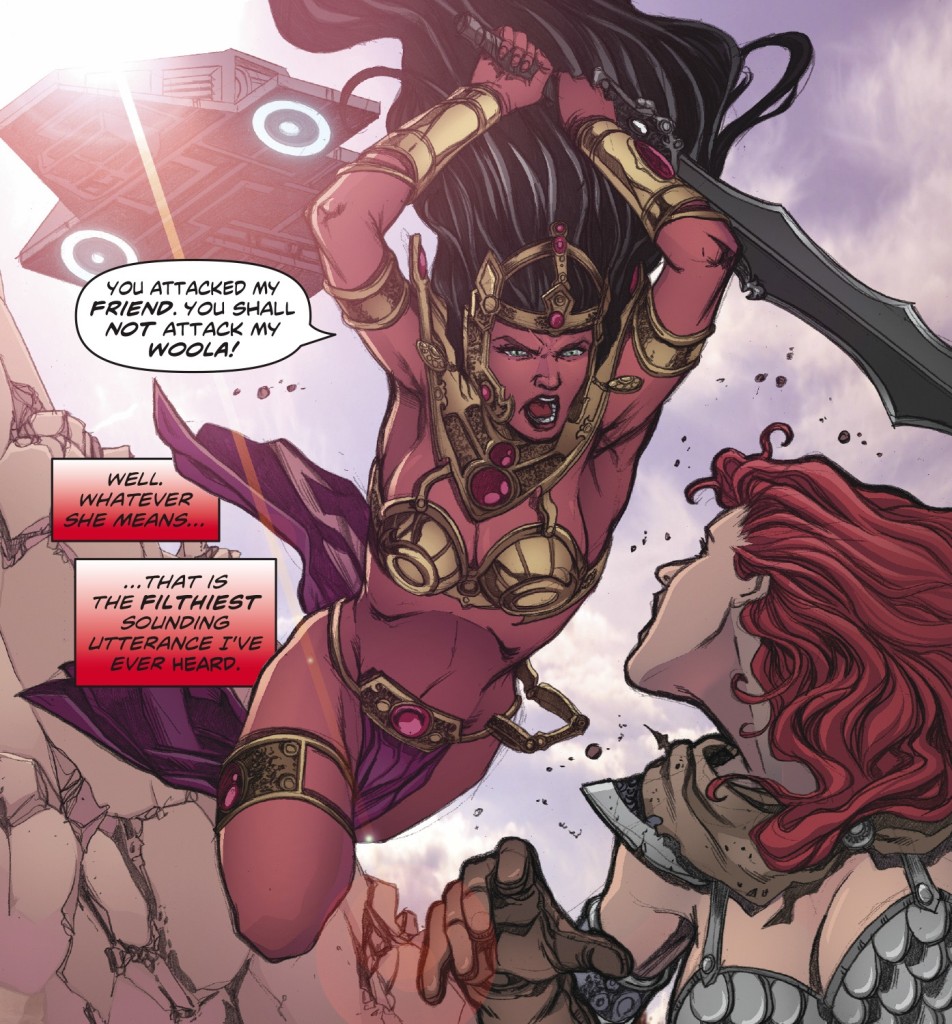 Swords of Sorrow #2
Swords of Sorrow #2
Along with the core book, there were one-shots and mini-series focusing on specific team-ups. Nancy A. Collins did the one where Jennifer Blood joined forces with the porny superhero Vampirella (whose own comics Collins was writing at the time).
Collins didn’t seem like a bad choice at all, as she’s always had a thing for comedic horror, directly riffing on Evil Dead II in her Swamp Thing run from the early ‘90s (and returning to the well soon after Swords of Sorrow, with Army of Darkness: Furious Road). The problem is that in this instance she appears to have phoned in an exposition-heavy script without bothering to develop any particularly original idea (although she did double down on the Breaking Bad references).
You’d think that in a company-wide event full of hot female killers dressed in black leather the tendency would be to highlight what distinguishes Jennifer from the rest, namely her connotation with suburban family life and her ambiguous search for a notional ‘normality’ (which could’ve made for a fun contrast with all the magical chaos), but this side of the character remained utterly disregarded. Curiously, surrounding Jen with craziness only made her feel even more generic, completing the franchise’s steady degeneration ever since Ewing had closed shop…
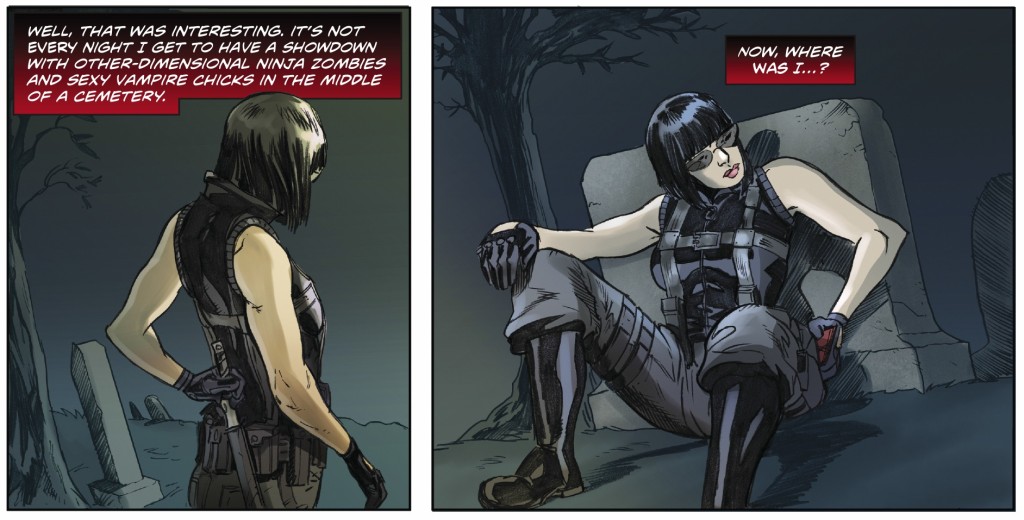 Swords of Sorrow: Vampirella & Jennifer Blood #4
Swords of Sorrow: Vampirella & Jennifer Blood #4
For a more successful attempt at bringing together diverse Dynamite properties, then the place to look would be 2020’s DIE!namite, an interdimensional zombie outbreak saga with a tongue lodged in its cheek, as you can no doubt tell by the title. Although the premise is just as derivative (it’s a barefaced variation on Marvel Zombies and DCeased), writers Declan Shalvey and Fred Van Lente wisely limited the main cast (with Red Sonja once again taking a leading role). Thus, despite the many cameos, they got to actually develop characters and relationships among all the breakneck action and comedy. They even managed to pull off a reboot of Peter Cannon, Thunderbolt, that’s more enjoyable than Kieron Gillen’s and Caspar Wijngaard’s recent meta-series.
The sequel, DIE!namite Lives, is even funnier. Besides riffing on the covid pandemic, the comic finally brings Jennifer Blood into the party and has a blast pitting her against Ash Williams (yep, from the Evil Dead/Army of Darkness franchise), although not before applying her talents to the slaughter of the undead, as wonderfully rendered by Vincenzo Carratù!
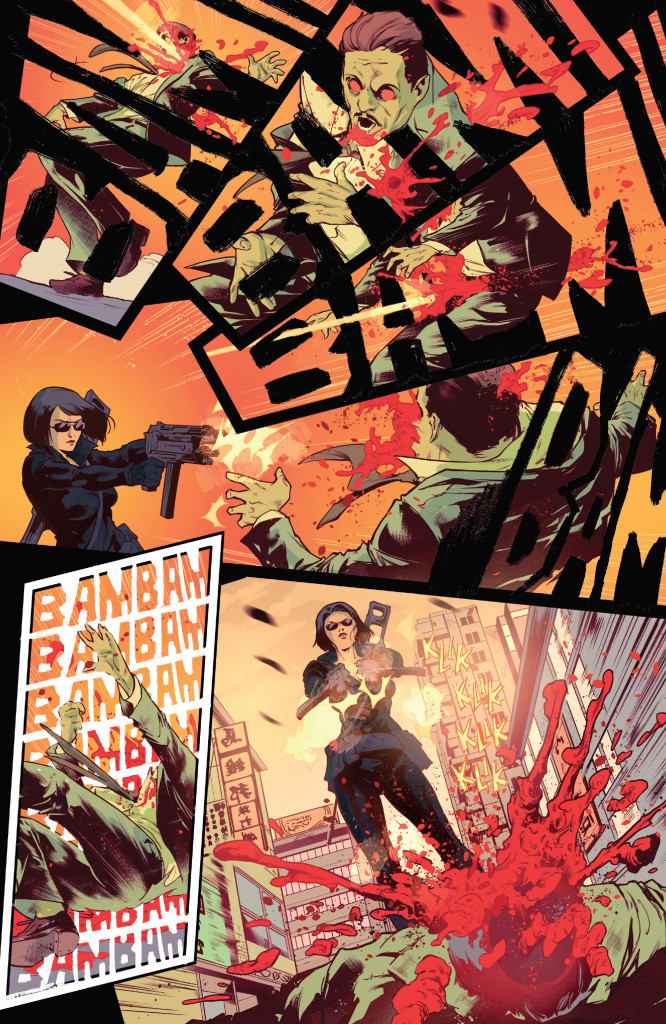 DIE!namite Lives #2
DIE!namite Lives #2
Fred Van Lente was also behind last year’s Jennifer Blood relaunch, which means that the franchise finally found its feet again. The first thing he did was to unleash Jen on an average-looking small town (basically a parody of Middle America) that turned out to be packed with criminals in the witness protection program. This was a brilliant move: it returned the character to a version of her original setting while at the same time turning things upside down… After all, here was an entire town full of Jennifer Bloods, i.e. full of extremely violent people posing as model citizens!
This time, the comic really hit the ground running. Artist Vincenzo Federici and colorist Dearbhla Kelly nailed the shine of a nostalgic Americana that seems to have popped out of a magazine advert. Plot-wise, the new series healthily disregards pretty much everything since Al Ewing’s run and puts its own spin on how the saga could’ve evolved from there (only fully revealed in the latest issue, which has a knockout twist). And if the Vampirella & Jennifer Blood mini had devoted five entire pages just to recapping Jennifer’s whole story, Van Lente efficiently told new readers everything they needed to know in less than a page… and he made it damn entertaining, to boot.
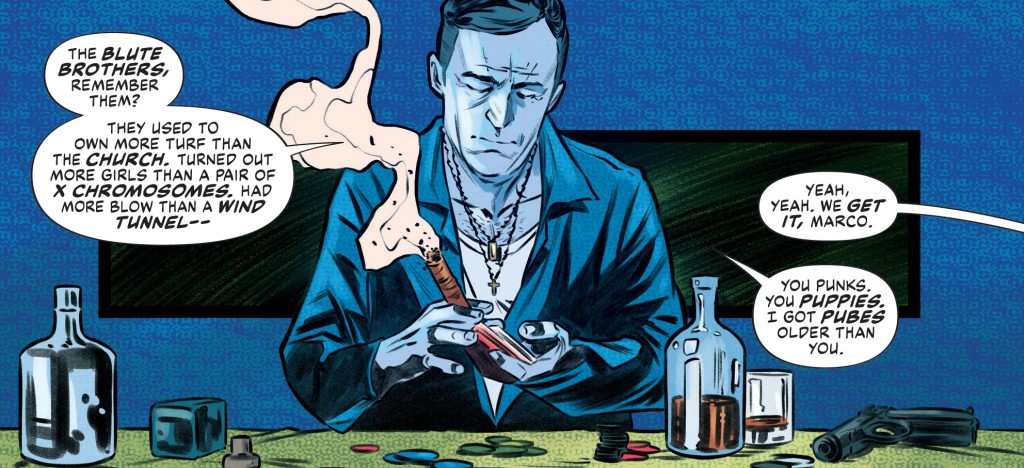 Jennifer Blood (v2) #1
Jennifer Blood (v2) #1
Fred Van Lente did his usual trick of figuring out a property’s specific subgenre and then playing to its strengths. In this case, he situated Jennifer Blood’s brand of kitsch mayhem in the lineage of slasher movies and, particularly, of garish Italian thrillers from the ‘70s (with an obvious layer of sexploitation on top). And just as he paid tribute to different horror directors in Marvel Zombies and to John Woo in Archer & Armstrong’s gun-heavy crossover with Bloodshot, here we get a racketeer called Don Giallo whose henchmen are named after Lucio Fulci and Dario Argento…
Along with such geeky winks, Van Lente has come up with set pieces inspired by the creative sadism commonly found in slasher fiction, like when Jennifer Blood chops up a guy and burns him in his own grill (‘Wacky bitch left his hands in the sign language for ‘J’ and ‘B!’’). So far, every issue has delivered glorious bloodfests. As a result, after all these years adrift, Jennifer Blood has somehow once again become one of my most exciting monthly reads!
That said, I’m not sure Dynamite really knows how to approach what they’ve got here. On the one hand, the sleazy covers continue to do a disservice to the material inside, probably putting off potential readers. On the other hand, it’s puzzling to imagine who the publisher thinks they’re targeting with this series, since they seem OK with the ultraviolence and the sexual content, but they now draw the line at swearing…


